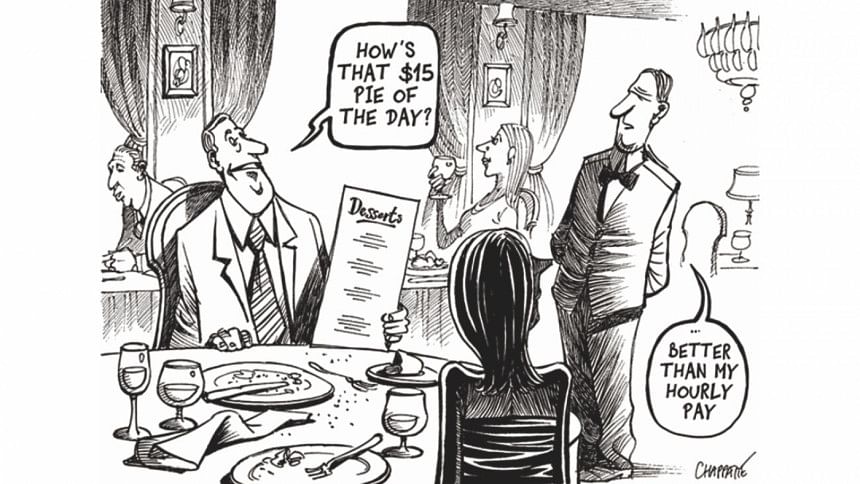Why inequality still matters

WHY do we discuss income inequality once again? For three reasons: 1) Income inequality in Bangladesh is very stark and socially unacceptable; 2) The trend for income inequality, as measured by Gini coefficients, indicates that it is increasing even if moderately; and 3) The share of income of the lowest rung of the income ladder is very meagre and has remained stagnant over the last two decades. For a nation that is experiencing income and employment growth, when the largesse brought about by globalisation and industrialisation is distributed quite unevenly or there is extreme poverty coexisting with conspicuous consumption, economic growth cannot be a goal or an end in itself.
Studies done by Unnayan Onneshan and other institutions indicate that the growing numbers of people living below the poverty line and a lack of income growth in the lowest 20 percent of the population have given rise to widespread hunger, destitution, and deterioration in the quality of life in rural areas. Furthermore, inflation, particularly food inflation is known to be associated with increase in income inequality. In the last decade, inflation in Bangladesh has been 6-8 percent with a stagnant nominal wage in the urban informal and rural markets.
Various indicators have pointed to a worsening trend in income and wealth inequality in Bangladesh, particularly in rural Bangladesh. For almost a century, the Gini coefficient, a simple statistical summary, has been used to measure income inequality. According to one study, income inequality in the country has increased in the last decades, as measured by the Gini coefficient which has increased from 0.451 in 2000 to 0.458 in 2010 at the national level. Income inequality has widened at a faster rate in the rural areas, with Gini coefficient increasing from 0.393 to 0.430 during the same period.
Other measures of income inequality in the country present a sharper contrast between the top and the bottom categories in the income ladder. If we compare the income accrued to the richest five percent of our population with the lowest five percent, the trends show that while the national income of the country has been growing at 5 percent since 1987, the share of the bottom 5 percent has declined from 1.03 percent to 0.77 percent and this is in sharp contrast to the income of the top 5 percent who have increased their share and now have almost 30 percent of the total income.
If we were to posit this trend against another widely used indicator of social well-being of the poor, we have corroborating evidence to indicate that the grip of poverty and inequality is very strong and alarming. According to the most recent Human Development Report, Bangladesh ranks 142nd out of 187 countries as measured by the Human Development Index. This is not as bad as it appears in view of the fact that we moved up four notches since 2013, and if we were comparing per capita only. However, strictly in terms of HDI--an index based on life expectancy at birth, mean years of schooling, expected years of schooling, and gross national income per capita-- we still rank just below both our largest and smallest neighbours, with India and Bhutan being ranked at 135 and 136 respectively.
Now if we turn to some of the richest countries, income inequality is increasingly coming under scrutiny for the destructive forces it unleashes. When Janet Yallen, the Chairman of the Federal Reserve Board of Governors of the US spoke before the House of Representatives earlier this year, she brought up the issue of income inequality in the US. Her remarks might be dismissed as a casual observation or just a flight of imagination for the Fed chief. But it is hardly so. Income inequality is a serious matter around the globe and not only academics but also political leaders, central bankers, and multi-governmental donors are taking notice.
Nobel Prize winning economist, Joseph Stiglitz in an Op-Ed piece for the New York Times on June 27 last year wrote that the argument for inequality cannot be made as a necessary condition for faster growth of GDP. Nor is it the by-product of growth. According to him, and research confirms that, greater inequality is a result of policy and politics.
One might argue that since income inequality is on the rise globally, why rail against it? Because it is ugly and like environmental degradation, it is an unmitigated evil. It is an eyesore, not only because it pricks our conscience, but also because it saps the energy of our people. And you don't have to be a radical or idealist to fight it. Finally, in order to reduce inequality in Bangladesh, much more needs to be done to improve access to employment, health and education for the bottom half of the population. We must rise to the challenge of both reducing inequality and improving education and welfare, whilst building the country's economy. There is no room for complacency.
The writer is an economist and often writes on public policy issues.

 For all latest news, follow The Daily Star's Google News channel.
For all latest news, follow The Daily Star's Google News channel. 



Comments